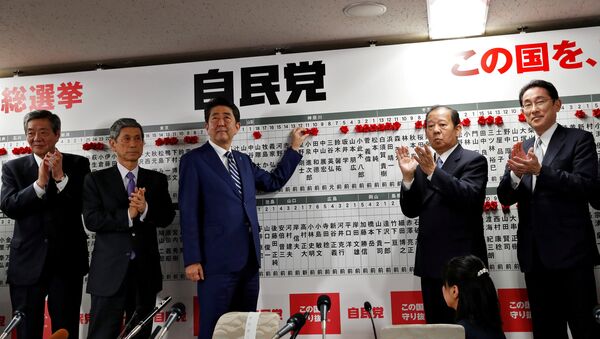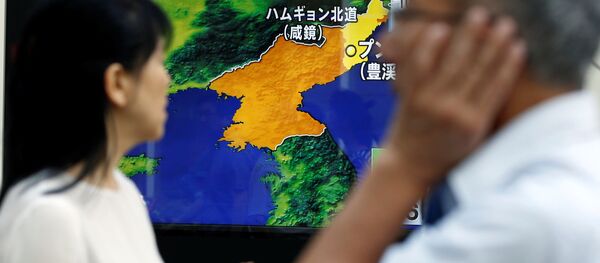MOSCOW (Sputnik) — Japan’s ruling coalition, comprising incumbent Prime Minister Shinzo Abe’s Liberal Democratic Party (LDP) and Komeito party, has secured a majority in the parliament's lower house, winning 310 out of 465 in the snap election, the Asahi newspaper reported Sunday.
Abe's LDP party is set to advocate for amendments to the country’s post-war constitution. In its current version, the constitution's Article 9 drafted by the US, bans the maintenance of armed forces. However, the Japanese government has managed to establish military forces that are used exclusively for self-defense. Moreover, in 2015 the government passed a bill, allowing the country's forces to fight abroad thus "defending the country's allies in case of war being declared upon them."
Commenting on the plans, Shinzo Abe said on Sunday that the decision regarding amendments to the country's constitution would not be made solely by the ruling coalition.
"We have set 2020 as our target year for amending the constitution, but we will put efforts to ensure the support of many people [for amendments] not by setting the deadline itself, but through enhancing discussions," Abe explained.
In order to amend the Japanese Constitution, it is necessary to receive the approval of two thirds of the deputies of the Japanese Parliament's both houses, after which the amendment is submitted to a referendum. The two-thirds of votes in the lower house is also sufficient in order to pass any bill by the second vote, even if it is rejected by the upper house.
The prime minister has promised to make all necessary efforts to tackle the North Korean crisis that has escalated in recent months due to the nuclear and missile tests performed by the latter.
Voter Turnout
Nearly 47,700 polling stations opened across the country at 07:00 local time (22:00 GMT Saturday). Most polling stations closed at 20:00 local time (11:00 GMT), while some polling stations, especially in the southern regions, were closed several hours earlier due to the approach of Lan, classified as a Category 4 Typhoon.
The highest voter turnout was recorded in Yamagata prefecture (39.85 percent). It is followed by Niigata prefecture (38.87 percent) and Iwate prefecture (36.18 percent). The lowest voter turnout was recorded in Okinawa prefecture (23.89 percent) and Saitama prefecture (24.37 percent).
The voter turnout was hindered by heavy rains and strong winds caused by the approaching typhoon. In addition, severe weather conditions disrupted marine traffic, which caused a delay in the delivery of ballot boxes from the remote islands of Matsuyama, Saga and Yamaguchi prefectures, which held the general election on Saturday. The ballot counting for these voting districts will be held on Monday




